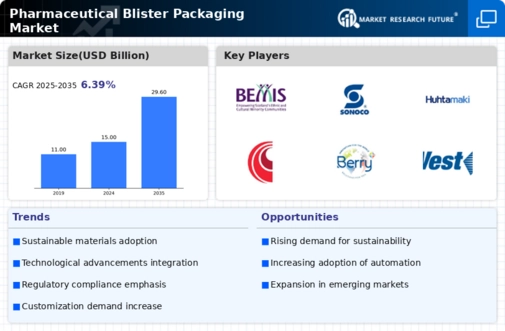Expansion of Biopharmaceuticals
The Pharmaceutical Blister Packaging Market is significantly influenced by the expansion of biopharmaceuticals. As the biopharmaceutical sector continues to grow, the need for specialized packaging solutions becomes increasingly critical. Biopharmaceuticals often require stringent storage conditions and protection from environmental factors, which blister packaging can provide. The market for biopharmaceuticals is expected to reach USD 500 billion by 2026, indicating a robust demand for effective packaging solutions. Blister packaging not only ensures the integrity of these sensitive products but also enhances their shelf life. This trend suggests that the blister packaging sector must adapt to meet the unique requirements of biopharmaceuticals, thereby driving innovation and growth within the industry.
Regulatory Pressures and Compliance
The Pharmaceutical Blister Packaging Market is also shaped by stringent regulatory requirements that govern packaging standards. Regulatory bodies are increasingly focusing on ensuring the safety and efficacy of pharmaceutical products, which directly impacts packaging solutions. Compliance with these regulations is essential for manufacturers, as non-compliance can lead to significant financial penalties and product recalls. The need for compliance drives innovation in packaging materials and designs, as companies seek to meet the evolving standards set forth by regulatory agencies. This trend suggests that the blister packaging market will continue to adapt and innovate in response to regulatory pressures, thereby enhancing the overall quality and safety of pharmaceutical products.
Technological Innovations in Packaging
Technological advancements are playing a pivotal role in shaping the Pharmaceutical Blister Packaging Market. Innovations such as smart packaging, which incorporates sensors and indicators, are becoming increasingly prevalent. These technologies enhance the functionality of blister packaging by providing real-time information about the product's condition, such as temperature and humidity levels. The integration of such technologies is expected to increase the market's value, with projections indicating a growth rate of around 7% annually. This evolution not only improves product safety but also aligns with the industry's shift towards more sophisticated and interactive packaging solutions. As technology continues to advance, the blister packaging sector is likely to see further enhancements that cater to both manufacturers and consumers.
Rising Demand for Patient-Centric Packaging
The Pharmaceutical Blister Packaging Market is experiencing a notable shift towards patient-centric packaging solutions. This trend is driven by the increasing emphasis on patient adherence to medication regimens. Blister packaging offers clear visibility of dosage, which aids patients in managing their medications effectively. Furthermore, the convenience of single-dose packaging is appealing to both patients and healthcare providers. According to recent data, the demand for such packaging solutions is projected to grow at a compound annual growth rate of approximately 6.5% over the next few years. This growth is indicative of a broader movement within the pharmaceutical sector to enhance patient experience and safety, thereby solidifying the role of blister packaging in modern healthcare.
Sustainability and Eco-Friendly Packaging Solutions
Sustainability is becoming a crucial driver in the Pharmaceutical Blister Packaging Market. As environmental concerns grow, there is an increasing demand for eco-friendly packaging solutions. Manufacturers are exploring biodegradable and recyclable materials to reduce their environmental footprint. This shift is not only beneficial for the planet but also aligns with consumer preferences for sustainable products. Market Research Future indicates that the demand for sustainable packaging is expected to increase by 8% annually, reflecting a broader trend towards environmental responsibility in the pharmaceutical sector. Companies that prioritize sustainability in their packaging strategies are likely to gain a competitive edge, as consumers and healthcare providers increasingly favor environmentally conscious options.

















Leave a Comment